Tooth extraction or extraction, as it is also called in medicine, is a surgical intervention in the mouth of a patient of a dentist to remove a dental unit from the soft tissues of the gums and alveolar ridge of the jaw. The removal technique, and, accordingly, the price of the procedure, depends on where the tooth is located, whether it is molar or milk, the clinical picture, the degree of damage.
In dentistry, all methods of tooth extraction are divided into 3 main types. The table below describes their features and prices.
| Removal type | Features of the procedure | Price, rub.) |
| Simple | The dentist uses special forceps to extract the entire tooth. The duration of the procedure is on average about 5 minutes. This method removes teeth with one root and affected by periodontitis. | 2000 |
| Difficult | To remove a molar, the doctor uses additional dental instruments, such as an elevator. The entire extraction procedure takes no more than 20 minutes. This technique is used if part of the root is fractured or part of the crown when extracting teeth with several roots. | From 3000 and above |
| Atypical | This technique is considered the most difficult, is carried out in several stages and can be time-consuming. When removing a tooth, a specialist can use a number of instruments: a bur, forceps, an elevator, a chisel, surgical needles and a floss to close the wound after extraction. Such removal can take up to 2 hours. | From 3000 |
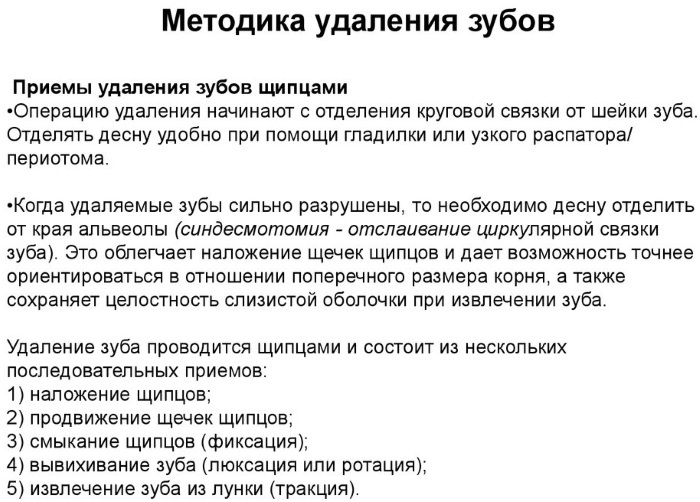
The extraction of a molar tooth occurs only in a dental office, after a complete examination and selection of an anesthetic.
Record content:
- 1 Advantages and disadvantages
- 2 Indications
- 3 Contraindications
- 4 Training
-
5 Procedure step by step
- 5.1 Simple removal technique
- 5.2 Complex technique
- 5.3 Atypical technique
- 5.4 Removing the root of a decayed tooth
- 5.5 Tooth extraction in children
- 6 Care procedures after
- 7 Possible complications
- 8 Tooth extraction video
Advantages and disadvantages
The extraction procedure has several advantages:
- the disappearance of sharp pain and discomfort, if any;
- the ability to install a crown, bridge and bracket system if the extracted tooth interfered with the procedure.
There are also disadvantages of this procedure:
- unaesthetic appearance, especially if the extracted tooth was in the smile zone;
- after the removal procedure, bleeding often appears, the hole from the tooth is delayed for a long time;
- speech impairment may appear;
- some difficulty while eating.
Indications
Removal of a molar tooth can be indicated for patients with:
- severe tooth decay;
- advanced form of pulpitis;
- fracture of the crown;
- the presence of a cyst at the apex of the tooth root;
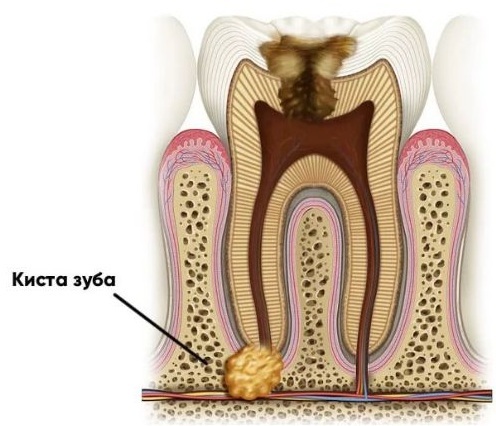
- full and partial retention is when the tooth cannot erupt on its own;
- incorrect position of the tooth;
- installation of a prosthesis, bridge or braces;
- the presence of a neoplasm.
Contraindications
There are no contraindications to the extraction of a molar tooth.
There are time limits when you need to postpone the procedure and it is recommended for:
- an inflammatory process that has affected the gums;
- acute form of chronic pathologies;
- high body temperature;
- serious disorders of the nervous system;
- acute forms of diseases of the heart and blood vessels;
- serious kidney disease;
- exacerbation of infectious hepatitis;
- diathesis accompanied by bleeding;
- stomatitis;
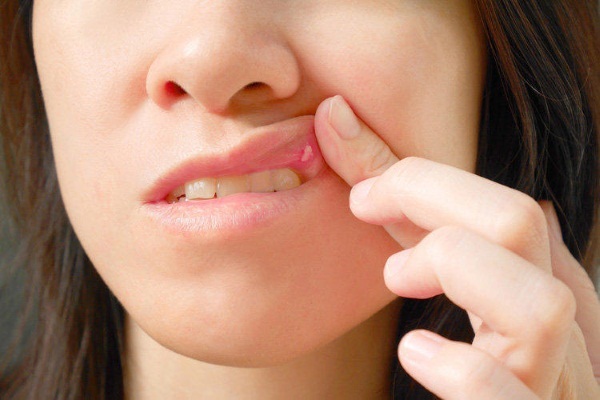
- acute ailments affecting the blood flow in the brain;
- high numbers on the tonometer;
- the period of menstruation in women, because during this period the blood clotting time increases, which ultimately can provoke bleeding after tooth extraction;
- purulent-septic processes that have affected the oral cavity;
- carrying a fetus in the first trimester and last month.
Training
The extraction of a molar tooth begins with a thorough examination of the patient and his preparation for the procedure. To assess the condition of the tooth, the doctor recommends to undergo an X-ray, and then carefully examine the entire oral cavity.
The specialist must:
- determine the condition of the tooth, how much it is destroyed;
- check with the patient if he is allergic to anesthetics;
- find out if there is an inflammatory process and temporary contraindications for manipulation;
- choose the right anesthetic;
- draw up an operation plan, choose the type of procedure;
- prepare the necessary tools.
It is imperative that before starting the procedure, the doctor processes the tissues located near the tooth that is supposed to be removed. And then he goes on to pain relief. Anesthesia may not be used if dentin is destroyed slowly, without inflammation and rot.
But more often the doctor still relieves itching, opting for one of the most effective anesthetics:
-
Novocaine. This anesthetic is rarely used, as many people are allergic to it.

- D. This is one of the most effective and safe anesthetics used in dentistry. It does not contain preservatives and is suitable for use in patients with heart and vascular problems.
When the anesthetic begins to act and the tissues around the removed tooth become numb, the doctor proceeds directly to the removal.
Procedure step by step
Tooth extraction can be carried out by one of 3 methods, each of which has its own number of instruments and stages of carrying out.
Simple removal technique
A simple method is used when you need to remove a tooth with a preserved crown. The procedure consists of the following stages:
- Detachment of the tooth ligament around its entire circumference. The specialist, armed with a trowel, removes the ligament from the oral and vestibular sides, so that later it would be easier to apply forceps. This step also helps to determine how well the anesthetic has worked.
- Forceps delivery. The cheeks of the forceps are moved apart to such a distance that the tooth exactly enters into it, the axis of the instrument should ideally coincide with the axis of the tooth.
- Promotion of the instrument. The cheeks of the instrument are pushed under the gum to create a feeling of complete coverage of the tooth crown.
- Fixation. By squeezing the handle of the forceps, the specialist fixes the tooth securely. A weak fixation will not give an opportunity to loosen and extract a tooth, and a strong fixation will break the crown.
- Dislocation. During the extraction, after a secure fixation of the tooth, the doctor can rotate the tooth, swing it. The direction of rotation should be directed towards less resistance, so for example, the tooth from the upper jaw is rotated outward, on the lower jaw 7 and 8, the teeth are loosened lingually, and the rest are buccal.
-
Extraction of a tooth. After the tooth is completely detached from the ligament that holds it, it is carefully removed from the socket.
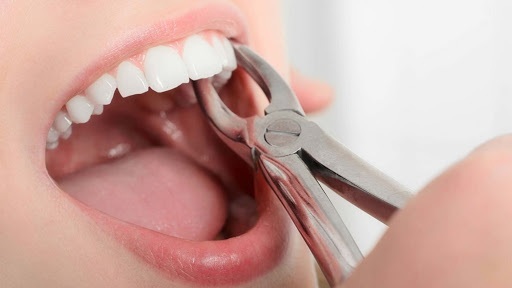
If the tooth sits firmly, then the specialist additionally takes an elevator. It is important for him to find good support. If the wall of the alveoli is thick, then the elevator should pass between the root of the tooth and the wall of the hole. After its installation, the tooth is slowly loosened using rotational movements. By removing the teeth from the lower row, a narrow elevator is fixed in the root area, after which the tooth is lifted, as if by a lever.
After tooth extraction, the socket is resected: granulation, bone fragments are removed, a tampon is applied and the patient is asked to close his jaw tightly. The tampon is kept for 20 minutes. Do not eat or rinse your mouth for 2 hours.
Complex technique
This method is used if:
- the wisdom tooth cannot erupt;
- 8 tooth is in the wrong position;
- extraction of teeth with 2-3 roots;
- the root of the tooth is twisted or destroyed;
- bone tissue has grown together with the root;
- the patient has a cyst or sinus tract;
- the tooth is fragile due to exposure to resorcinol-formalin paste.
During a complex tooth extraction technique, the doctor can use: forceps, an elevator, a chisel, a drill and other instruments.
Removing a wisdom tooth with a complex technique consists of the following stages:
- an incision is made in the soft tissues, the gum is separated from the neck of the tooth;
- if necessary, sections of bone tissue are additionally cut out, inter-root partitions are cut;
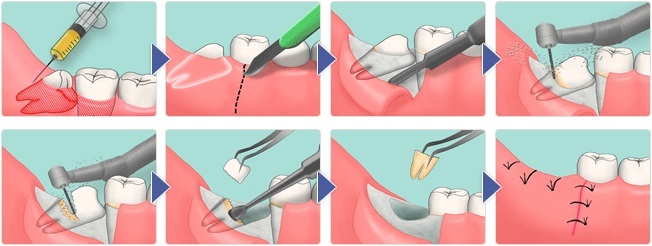
Removal of a molar wisdom tooth - forceps are applied to the crown, the instrument is lowered into the alveolus until it stops;
- the forceps are clamped and fixed, but without strong pressure;
- the tooth swings and is removed from the hole;
- sutures are placed on the gum in the place of the extracted tooth.
Tissue healing after complex manipulation occurs within a week. After the anesthetic wears off, you can take a pain reliever pill.
Atypical technique
It is used in the case of a non-erupted tooth, to remove supernumerary teeth or if the root apex is broken.
The procedure is carried out as follows:
- an incision is made in the projection of the tooth to be removed;
- using a float and a raspator, the flap is separated from the bone;
- a cooling bur helps to remove the bone plate
- when removing an impacted tooth, the entire bone is cut out around the crown, and then it is dislocated with an elevator;
- when removing a tooth with a broken off top, the walls of the alveoli are cut down, and then the top is taken out with a narrow elevator;
- after tooth extraction, the hole is treated with an antiseptic, sutures are applied.
Removing the root of a decayed tooth
Often people turn to a dentist for help when the tooth has already completely collapsed, and only the root remains in the gum. The procedure is carried out only after filling the canals, preliminarily using local anesthesia. The procedure itself is not complicated, its duration is no more than half an hour.
Its main stages:
- the doctor preliminarily collects the patient's anamnesis;

- then the operating field is disinfected;
- local anesthesia is applied;
- the gum is cut to allow access to the root;
- soft tissues exfoliate;
- a small part of the bone is cut out;
- cutting off the inflamed area of the root with a granuloma or cyst;
- a special drug is placed in the cavity, which stimulates the growth of bone tissue;
- suturing.
Tooth extraction in children
For children, the procedure for tooth extraction is different. Initially, before entering the dentist's office, the child must be psychologically prepared so that the removal went quickly:
- not to discuss with the child the reason for the tooth extraction, not to use any complicated terms from the dentist's arsenal in conversation;
- do not frighten the child by the doctor;
- adults also should not worry that their condition is not transmitted to the child;
- you can take the child to the dentist's office when one of the parents will have a tooth treated, so that he understands that there is nothing terrible in the procedure;
- tell the child that he is very brave and courageous, once he goes to the dentist's office;
- do not deceive the baby that the procedure is painless, you need to tell that the discomfort is insignificant and will quickly pass.
The removal procedure itself consists of the following stages:
- Forceps are applied to the crown; for children, special small-sized ones are used that do not injure the gums. Fixes the tooth freely, as in children they are more fragile than in adults and even a little pressure can split them.
- Next, the dentist performs a dislocation of the tooth.
- The tooth is removed from the socket.
- The technician checks that all roots have been removed.
- A sterile swab is applied to the well.
As anesthesia, children use an application technique, when the gum is treated with a special gel and spray at the site of the tooth being removed. After tooth extraction, the doctor makes recommendations to the patient in order to prevent the development of complications.
Care procedures after
Removal of a molar is a surgical procedure, after which pain may be observed for some time.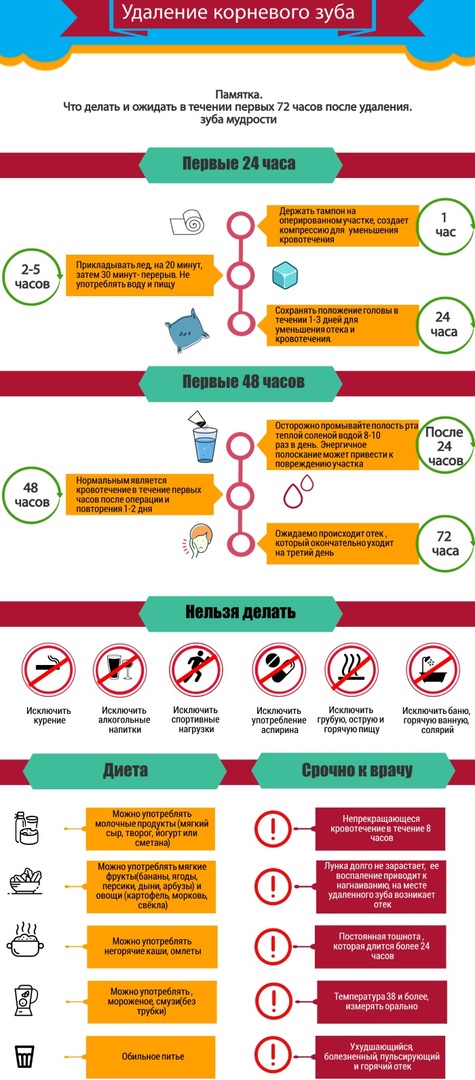
In order for tissue healing after removal to go faster, you need to take on board several recommendations of dentists:
- apply a cold compress to the site of edema;
- do not warm up your mouth so as not to provoke the development of inflammation;
- do not neglect hygienic procedures, but avoid the gum area at the site of tooth extraction;
- during the day after removal, avoid taking hot, spicy and solid foods;
- do not chew food on the injured side;
- it is allowed to use a decoction of medicinal herbs or special antiseptics to relieve pain.
2-3 hours after the extraction of the tooth, the effect of the anesthetic ends and the pain may return. In this case, the doctor may advise you to take a pain reliever, for example, Nimid in powder form.
The cavity can be treated with an anesthetic, for example, 0.05% Chlorhexidine solution. But you cannot rinse the tooth, otherwise you can wash the blood clot from the hole and food will be stuffed into it, rot and provoke inflammation. An antiseptic is simply put in the mouth, held for a couple of minutes and spit out.
If the tooth was removed due to inflammation, a complex method was used or there is a risk development of complications, the dentist may recommend taking an antibiotic:
- Amoxiclav. Take 1 tablet (625 mg) 2 times a day. The course is not more than a week.
- Unidox solutab. Take 1 tablet (100 mg) 2 times a day for up to 5-7 days.
- Lincomycin. Take 2 capsules (0.25) 3 times a day for up to 7 days.
Possible complications
Tooth extraction is a minor surgical intervention in the human body, due to the origin of various complications.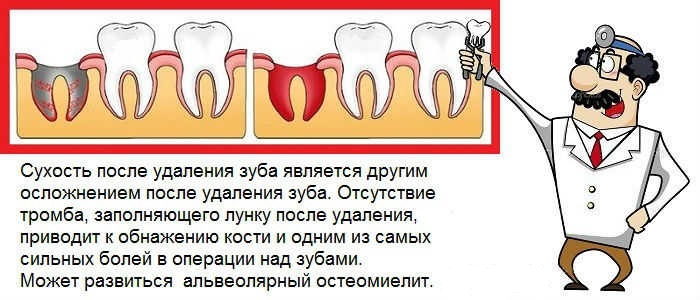
Contributing factors in the extraction of a molar can be the following circumstances:
- wound infection, which can occur due to non-compliance with hygiene rules, as well as non-compliance with the recommendations of a specialist;
- inflammation of the lymph nodes located near the extracted tooth;
- bleeding from a wound or soft tissues adjacent to the tooth, as a result of which hematomas often form, and then their suppuration;
- damage to healthy teeth damage to the alveolar process, as a result of which it will no longer be possible to implant the implant;
- inflammation of the alveolar socket;
- nerve damage, especially when a wisdom tooth is removed;
- dislocation of the jaw.
The most dangerous complication after tooth extraction is inflammation. Its development is due to pathogens. Inflammation can easily provoke a diffuse purulent-septic process. The circulatory system of the jaw is well developed, therefore it contributes to the rapid spread of infection throughout the body. As a result, it can threaten with sepsis. The onset of inflammation can be determined by high temperature and persistent edema.
An urgent need to consult a dentist if other symptoms are observed:
- if swelling at the site of the extracted tooth persists for 3 days;
- discomfort does not go away, but rather intensifies;
- general malaise is observed: lymph nodes are enlarged, drowsiness, weakness, headache, fever;
- the appearance of an unpleasant odor from the oral cavity.
Removing or extracting a molar is a minor surgical procedure, but failure to follow the recommendations can lead to serious complications. That is why the procedure should be carried out by a highly qualified specialist, and the patient should strictly follow all recommendations.
Tooth extraction video
It hurts and pulling out molars:



